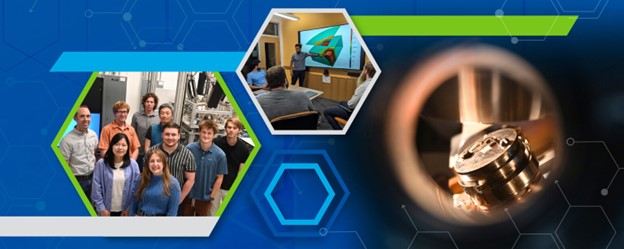by Emi Walker (August 12, 2024)
NC State University Department of Nuclear Engineering doctoral student, Grayson Gall, was one of the six interns at the INL Fusion Safety Program. Grayson is co-advised by Drs. Amanda Lietz & Steven Shannon. One of Gall’s INL advisers, Dr. Casey Icenhour, is an alumnus of our doctoral program.
Imagine a future where the energy powering your home is the same energy that lights up the stars. This isn’t science fiction. It’s the promise of fusion, and it’s closer than you think.
Fusion is the process of combining atomic nuclei to form heavier atoms, releasing substantial amounts of energy. Unlike stars, which fuse regular hydrogen due to their immense gravity, earthbound engineers use hydrogen’s heavier isotopes—deuterium and tritium—to initiate fusion creating helium, a neutron and energy. Deuterium is readily available, but tritium must be bred from lithium using the neutrons produced by the fusion reaction.
Fusion energy’s potential is staggering: Just 11.6 grams of lithium, about the amount in three laptop batteries, could satisfy the lifetime energy needs of an average American.
In December 2022, researchers from Lawrence Livermore National Laboratory announced a fusion milestone that scientists have been chasing for decades: In an experiment at the National Ignition Facility, they produced a fusion reaction that produced more energy than it consumed.
For over 40 years, Idaho National Laboratory’s Fusion Safety Program has worked to enable the Department of Energy’s goal of a clean, safe and economical fusion energy future by providing unique tritium handling facilities and leading-edge modeling tools that impact the global fusion research community. These capabilities position INL at the forefront of fusion safety research, offering critical insights into the behavior of tritium within materials and fusion systems.
Now, INL is creating opportunities for students to work hand-in-hand with Fusion Safety Program experts as they address challenges facing tomorrow’s fusion industry.
Developing a fusion workforce through intern training
“Interns at INL, from high schoolers to Ph.D. students, are working at the cutting edge of research, contributing to significant projects and earning accolades for their work,” said Pierre-Clément Simon, an INL computational scientist and chair of the lab’s Early Career Researchers Association.
Growing the fusion industry requires collaboration with other national laboratories, universities and private companies, Simon said. These partnerships foster innovation and support the development of a skilled workforce ready to meet the demands of a fusion-powered future.
“With a budding fusion industry, the next generation of fusion researchers must be trained,” said INL staff scientist Thomas Fuerst. “The INL Safety and Tritium Applied Research (STAR) facility provides a unique training ground for students to gain hands-on experience working on the technology to make fusion energy happen. ”Surface analysis of the vanadium installed in the tritium extraction experiment.
Projects for the timely and safe implementation of fusion energy
The DOE Office of Science, and other sources, fund INL’s fusion research, allowing the team to make pivotal contributions to the department’s fusion energy mission.
INL’s fusion projects include the intricate task of tritium extraction (a key component of fueling the fusion reactor), pioneering tritium retention studies and developing open-source, high-fidelity modeling capabilities that are shaping the future of fusion system design.
“Each project serves the overarching goal of ensuring the timely and safe implementation of fusion energy, while addressing the fundamental challenges of tritium processing and developing the necessary technology for this groundbreaking work,” said Masa Shimada, an INL distinguished staff scientist who is the experimental lead for the Fusion Safety Program.
Idaho National Laboratory has marked important progress in fusion technology with the initiation of the Tritium Extraction eXperiment (TEX). This project aims to demonstrate and confirm the process for extracting tritium from breeder materials in fusion reactors, representing a notable advance in the field.
Read the full article here.

